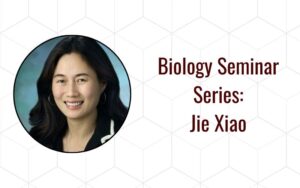Biology Seminar Series: Jie Xiao
By: TAMU Biology
Dr. Jie Xiao to Speak on Single Molecule View of Bacterial Cell Division
 The Department of Biology is pleased to announce that Dr. Jie Xiao will be the guest speaker on Tuesday, April 15, 2025, at 4:00 PM in BSBE 115. The event will be hosted by Dr. Beiyan Nan.
The Department of Biology is pleased to announce that Dr. Jie Xiao will be the guest speaker on Tuesday, April 15, 2025, at 4:00 PM in BSBE 115. The event will be hosted by Dr. Beiyan Nan.
About Dr. Jie Xiao
Dr. Jie Xiao grew up in Chongqing, China, and received her undergraduate education in Biochemistry from Nanjing University. She completed her Ph.D. in Biochemistry and Cell Biology under the guidance of Prof. Scott Singleton at Rice University in 2002. Following her graduation, Dr. Xiao received postdoctoral training in single-molecule biophysics from Prof. Sunney Xie at Harvard University. In 2006, she established her lab in the Department of Biophysics and Biophysical Chemistry at Johns Hopkins School of Medicine, where she became a full professor. Dr. Xiao’s research focuses on developing innovative single-molecule approaches to investigate the structures, functions, and dynamics of bacterial macromolecular machineries involved in transcription, genome organization, and cell division.
Lecture Title
Proteins and Things That Go – A Single Molecule View of Bacterial Cell Division
Abstract
The bacterial cell wall is a single macromolecule composed of a mesh network of cross-linked peptidoglycans (PG). During cell division, the cell wall provides mechanical stability and protection to the cell and is carefully remodeled and constricted to allow cell division without the risk of lysing. This process is orchestrated by a myriad of cytoskeletal proteins, PG processing enzymes, and their associated regulators. Recent studies from Dr. Xiao’s group and others have discovered that FtsZ, an essential tubulin homolog, uses its GTP hydrolysis to power treadmilling dynamics to distribute the core sPG synthase complex FtsQLBWI (formed by FtsQLB, a tripartite divisome subcomplex, FtsW, the glycosyltransferase, and FtsI, the transpeptidase) evenly along the septum to ensure smooth, symmetric septum formation. Dr. Xiao’s research shows that the core complex can also exit treadmilling FtsZ polymers to initiate processive septal cell wall synthesis, which requires the presence of FtsN, another essential divisome protein that binds to denuded PG, an intermediate of septal cell wall along the destruction pathway. Using single-molecule imaging, computational modeling, and mutagenesis, Dr. Xiao investigates the structure, dynamics, and activation mechanism of the core complex FtsQLBWI and its coordination with septal cell wall degradation.





